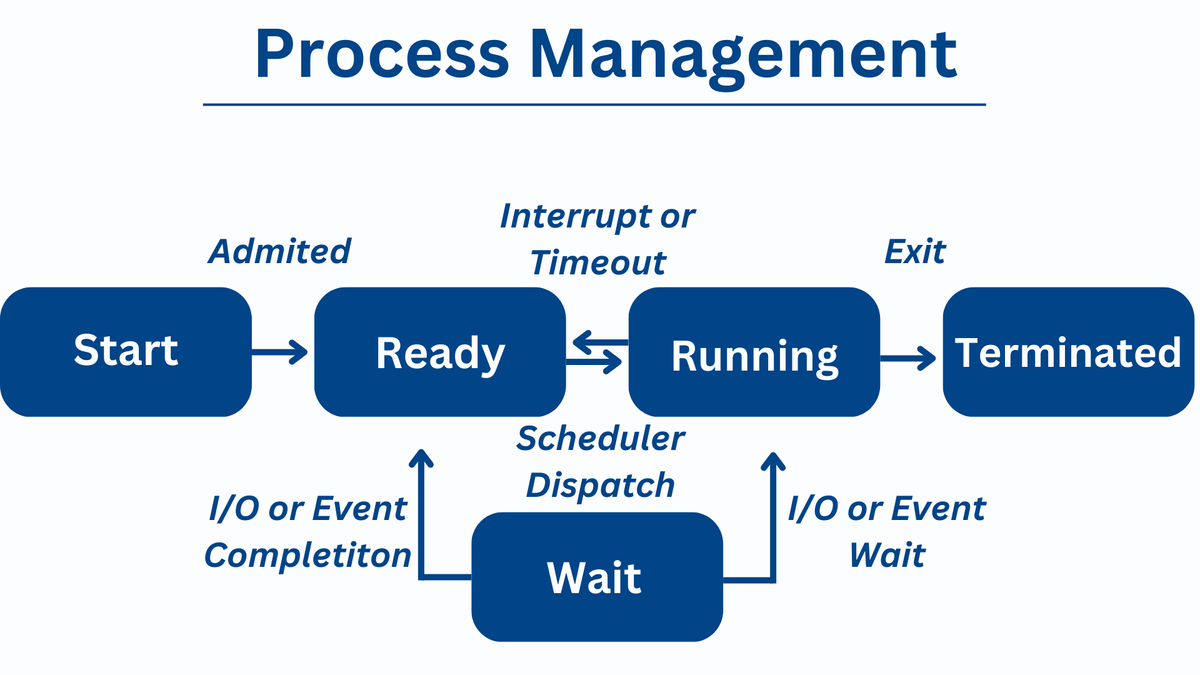What is a Process in OS?
A process is an instance of an executing program that is isolated from other programs. It is an abstraction that represents the execution of a program in a system. A process consists of a program code, program counter, registers, and variables that describe its current state. Each process is assigned a unique identifier that distinguishes it from other processes in the system.

What is Process Control?
Process control refers to the mechanisms and techniques used by an operating system to create, schedule, and terminate processes. It involves managing the execution of multiple processes simultaneously to ensure that they do not interfere with each other and that system resources are used efficiently.
Process Control Blocks (PCBs)
A process control block (PCB) is a data structure that contains information about a process. It includes the process state, program counter, memory, CPU registers, and other relevant information. The OS uses the PCB to keep track of each process’s status and to manage its execution.
The Role of Process Management in OS
Process management is a vital component of OS that ensures the proper allocation and utilization of system resources. It is responsible for creating, scheduling, and terminating processes. Process management plays a significant role in ensuring that the system is stable and responsive, preventing deadlocks, and allocating system resources efficiently.
Process Creation
The process creation is the first step in process management. The OS creates a new process when a user initiates a program. The new process is given a unique identifier, and the necessary system resources are allocated to it. The program code is loaded into memory, and the execution of the process begins.
Process Scheduling
Process scheduling is the mechanism that determines which process should run next. The scheduling algorithm ensures that all processes get a fair share of the system resources. The scheduler uses different scheduling algorithms to decide which process should be executed next.
Process Termination
Process termination is the final step in process management. It is the process of freeing up the resources that were allocated to the process. The OS releases the memory, CPU, and I/O devices that were being used by the process. This step is crucial to ensure that the system resources are used efficiently.
Process States in OS
- Ready: The process is ready to be executed.
- Running: The process is currently being executed by the CPU.
- Blocked: The process is blocked and waiting for a resource to become available.
- Terminated: The process has completed its execution.
What are Cooperating Processes ?
Cooperating processes are a group of processes that work together to accomplish a common goal. They communicate and coordinate with each other to share resources, synchronize their efforts, and solve problems. Each process is aware of the state of other processes and shares information to achieve their objectives.
Features of Cooperating Processes
- Shared memory: Processes can share a common area of memory to exchange data and information.
- Message passing: Processes can communicate with each other by sending and receiving messages.
- Semaphores: Semaphores are a synchronization mechanism that processes can use to control access to shared resources.
What is Inter-process Communication?
Interprocess communication (IPC) is a mechanism that enables communication and data sharing between different processes running on the same or different machines. IPC allows processes to exchange information, cooperate with each other, and coordinate their activities.
Types of Inter process Communication
There are several types of interprocess communication mechanisms that operating systems provide, including:
- Shared memory: Processes can share a common area of memory to exchange data and information.
- Message passing: Processes can communicate with each other by sending and receiving messages.
- Pipes: Pipes are a unidirectional communication channel that enables one-way communication between two processes.
- Sockets: Sockets are endpoints for communication between processes over a network.
- Remote procedure calls (RPC): RPC is a protocol that allows a process to execute a procedure on a remote machine.
Advantages of Interprocess Communication
Interprocess communication has several advantages, including:
- Resource sharing: IPC allows processes to share resources, such as memory, files, and devices.
- Synchronization: IPC can synchronize the activities of different processes to prevent conflicts and deadlocks.
- Flexibility: IPC enables communication and cooperation between different types of processes, such as client-server applications, distributed systems, and parallel computing.
Conclusion
Challenges of Interprocess Communication
Interprocess communication can also present several challenges, including:
- Security: IPC can expose vulnerabilities that hackers can exploit to gain unauthorized access to resources or data.
- Deadlocks: IPC can cause deadlocks when two or more processes wait for each other to release resources.
- Overhead: IPC can add overhead to the system, reducing its performance and efficiency.
Process management is a fundamental concept in operating systems that ensures the efficient allocation and utilization of system resources. It involves creating, scheduling, and terminating processes, which are essential components of any OS. Understanding the basics of process management is essential for computer science students and IT professionals who work with operating systems.
Related Topics
- Batch Operating System
- Time-Sharing Operating Systems
- Distributed Operating Systems
- Network Operating Systems
- Real-Time Operating Systems
- Scheduling
- Multi Purpose Scheduling
- Preemptive and Non Preemptive Scheduling
- Synchronization
- Semaphores
- Deadlock
- Process Management